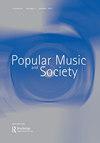Sensing Vinyl: Ritual, Memory, Materiality
IF 1
3区 艺术学
0 MUSIC
引用次数: 0
Abstract
ABSTRACTOnce relegated to the dustbins of media history, the vinyl LP has had a revival since the late aughts, becoming popular among all segments of music consumers, from those for whom it was the dominant medium of their youth to people who grew up only ever accessing music digitally. How is it that a format as clunky, costly, and fragile as vinyl would be so popular in an age of ubiquitous digital content? To address this question, this paper discusses vinyl’s aesthetics, sensorial qualities, and sociocultural affordances, and explores questions about ritual, memory, and materiality.KEYWORDS: Audiophilememorynostalgiasensesvinyl AcknowledgmentsThank you to the reviewers appointed by the journal for their valuable comments and suggestions. Several colleagues offered helpful feedback on earlier drafts of this paper. Thanks to Sheryl Hamilton, Ira Wagman, Michael Mopas, Vincent Andrisani, David Jackson, Chris Russill, and Brett Popplewell. Finally, I wish to acknowledge the Faculty of Public Affairs at Carleton University, which provided a Research Initiation Grant that helped support the broader project from which this paper stems.Disclosure StatementNo potential conflict of interest was reported by the author(s).Notes1. The broader project entails interviews with more than 40 owners and/or managers of independent record stores in all regions of Canada. Most of these interviews were conducted in person and on site, with others completed via Zoom. I draw from some of the findings here; however, the main analytical arguments from this research will be the subject of a companion paper.2. Waldron named The White Room after the popular B.B.C. music television program of the same name. Although the space is used to host the record club, its primary purpose is for hosting private parties, which it has done since long before the record club began.Additional informationFundingThe work was supported by the Faculty of Public Affairs, Carleton University [Research Initiation Grant].Notes on contributorsJosh GreenbergJosh Greenberg is Professor of Communication and Media Studies in the School of Journalism and Communication at Carleton University. My primary area of scholarship and professional activity is health, risk, and crisis communication, about which I have published extensively for more than two decades. As an avid and active vinyl collector and live music enthusiast, I have always had an interest in exploring the intersections of popular music, music technology, and fandom, and continued to read broadly in these areas. My BA honours thesis in sociology was on Deadhead collector culture and the emerging impact of the Internet on the storage, curation, and trade of bootleg Grateful Dead concert tapes. I‘m exciting to move this longstanding interest in vinyl music more centrally into my research and teaching.感应乙烯基:仪式,记忆,物质性
黑胶唱片一度被扔进媒体历史的垃圾箱,但自20世纪80年代末以来,它又复兴了,在各个音乐消费者中流行起来,从那些年轻时把黑胶唱片作为主要媒介的人,到那些在成长过程中只接触过数字音乐的人。在数字内容无处不在的时代,像黑胶唱片这样笨重、昂贵、脆弱的格式怎么会如此受欢迎呢?为了解决这个问题,本文讨论了黑胶的美学、感官品质和社会文化支持,并探讨了有关仪式、记忆和物质性的问题。感谢本刊指定的审稿人提出的宝贵意见和建议。几位同事对本文的早期草稿提供了有益的反馈。感谢谢丽尔·汉密尔顿、艾拉·瓦格曼、迈克尔·莫帕斯、文森特·安德里萨尼、大卫·杰克逊、克里斯·拉塞尔和布雷特·波普尔韦尔。最后,我要感谢卡尔顿大学公共事务学院,它提供了一笔研究启动基金,帮助支持了这篇论文所源于的更广泛的项目。披露声明作者未报告潜在的利益冲突。这个更广泛的项目需要采访加拿大所有地区的40多家独立唱片店的老板和/或经理。这些采访大多是亲自和现场进行的,其他的则通过Zoom完成。我从这里的一些发现中得出结论;然而,本研究的主要分析论点将是另一篇论文的主题。沃尔德伦以英国广播公司颇受欢迎的同名音乐电视节目为《白房间》命名。虽然这个空间是用来举办唱片俱乐部的,但它的主要目的是举办私人聚会,早在唱片俱乐部成立之前,它就已经这样做了。本研究得到了卡尔顿大学公共事务学院[研究启动基金]的支持。作者约什·格林伯格约什·格林伯格是卡尔顿大学新闻与传播学院传播与媒体研究教授。我的学术研究和专业活动的主要领域是健康、风险和危机沟通,关于这一点我已经发表了20多年的文章。作为一个狂热和活跃的黑胶收藏家和现场音乐爱好者,我一直对探索流行音乐、音乐技术和乐迷的交叉点感兴趣,并继续在这些领域广泛阅读。我的社会学荣誉学士学位论文是关于“死乐队”的收藏家文化,以及互联网对“感恩而死”的盗版音乐会磁带的储存、管理和交易的新影响。我很高兴将这种长期以来对黑胶音乐的兴趣更集中地转移到我的研究和教学中。
本文章由计算机程序翻译,如有差异,请以英文原文为准。
求助全文
约1分钟内获得全文
求助全文
来源期刊

POPULAR MUSIC AND SOCIETY
MUSIC-
CiteScore
1.10
自引率
0.00%
发文量
33
期刊介绍:
Popular Music and Society, founded in 1971, publishes articles, book reviews, and audio reviews on popular music of any genre, time period, or geographic location. Popular Music and Society is open to all scholarly orientations toward popular music, including (but not limited to) historical, theoretical, critical, sociological, and cultural approaches. The terms "popular" and "society" are broadly defined to accommodate a wide range of articles on the subject. Recent and forthcoming Special Issue topics include: Digital Music Delivery, Cover Songs, the Music Monopoly, Jazz, and the Kinks. Popular Music and Society is published five times per year and is a peer-reviewed academic journal supported by an international editorial board.
 求助内容:
求助内容: 应助结果提醒方式:
应助结果提醒方式:


